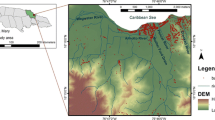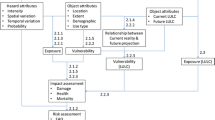Abstract
This paper presents the initial results of a common methodology for the evaluation of damage produced by a flood. A model has been developed for flood damage estimation based on a geographic information system (GIS). It could be used by land administration bodies and insurance companies to manage flood-related damage data. The model simulates flood scenarios and evaluates expected economic losses from the impact of floodwaters on exposed elements, through the application of a computational model elaborated by GIS. During the development of the model, the Boesio Stream, a small watercourse flowing into Lake Maggiore (Lombardy, northern Italy) which was recently affected by a flash flood, was used as case study to test and calibrate the methodology. The method could be used either as a forecasting tool to define event scenarios, utilizing data from events simulated with a hydraulic model, or for real-time damage assessment after a disaster. The approach is suitable to large-area damage assessment and could be appropriate for land use planning, civil protection and risk mitigation.







Similar content being viewed by others
References
Agenzia del Territorio—Osservatorio del Mercato Immobiliare (2007) Banca Dati delle Quotazioni Immobiliari, Agenzia del Territorio: Italy. Available at www.agenziaterritorio.it/servizi/osservatorioimmobiliare
CNR-GNDCI (1988) Progetto Speciale per la Valutazione delle Piene in Italia: Italy. Available at http://caronte.gndci.cs.cnr.it/GNDCI/Vapi.htm
Damage Project (2004) Développement d’Actions pour le Marketing et la Gestion post-évènements, Programme INTERREG IIIB Medocc, EU
EM-DAT (2007) International Disaster Database, Université Catholique de Louvain: Brussels, Belgium. Available at www.em-dat.net
FEMA (2003) Hazard MH—Multi-hazard Loss Estimation Methodology, Federal Emergency Management Agency: USA
Giandotti M (1934) Previsione delle piene e delle magre dei corsi d’acqua, Memorie e studi idrografici, Pubbl. 2 del Servizio Idrografico Italiano: Rome, Italy, Vol. VIII, p 107
Giandotti M, Visentini M (1938) Le sistemazioni di un bacino idrografico in generale, Biblioteca della Bonifica Integrale: Florence, Italy, Vol. 5
Kottegoda NT, Rosso R (1997) Statistics, probability and reliability for civil and environmental engineers. McGraw-Hill, New York
Pasini F (1914) Relazione sul progetto della bonifica renana, Bologna, Italy
Pezzoli G (1970) Schemi e modelli matematici in idrologia, Libreria editrice universitaria Levrotto & Bella: Turin, Italy
Queensland Government (2002) Disaster loss assessment guidelines, Illycroft Pty Ltd: Queensland, Australia, p 111
U.S. Soil Conservation Service (1986) Technical Release 55: Urban Hydrology for Small Watersheds, USDA (U.S. Department of Agriculture): USA
Van der Sande C (2001) River flood damage assessment using IKONOS imagery, E.C. Joint Research Centre & S.A.I.: Ispra, Italy, p 77
Ventura G (1905) Sulla bonifica della bassa pianura Bolognese, Giornale del Genio Civile: Italy
Acknowledgements
We would like to thank A. Zamperone for the hydrologic–hydraulic study and D. Alexander for their suggestions and revising the English text. A particular thanks for the collaboration to Philip J. Schneider, Director of the Multihazard Loss Estimation Program, National Institute of Building Sciences, Washington DC.
Author information
Authors and Affiliations
Corresponding author
Rights and permissions
About this article
Cite this article
Luino, F., Cirio, C.G., Biddoccu, M. et al. Application of a model to the evaluation of flood damage. Geoinformatica 13, 339–353 (2009). https://doi.org/10.1007/s10707-008-0070-3
Received:
Revised:
Accepted:
Published:
Issue Date:
DOI: https://doi.org/10.1007/s10707-008-0070-3




